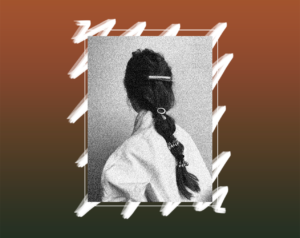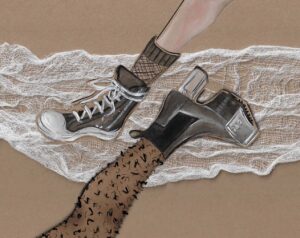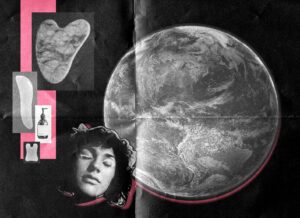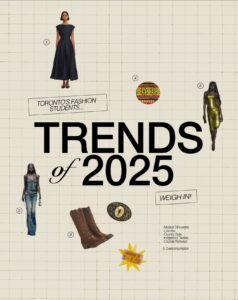GRAPHIC DESIGN Sam Cass
On Saturday, April 3, ancient Egyptian heritage, culture, and fashion all came together to celebrate pharaonic history. 22 royal mummies––18 kings and four queens––were paraded through the streets of Cairo, beginning their journey from their old museum in Tahrir Square, to their final resting place at the National Museum of Ancient Egyptian Civilization in an unparalleled procession known as the Pharaohs’ Golden Parade.
The mummy transfer turned into a multimillion-dollar extravaganza. Golden ancient Egyptian decorated carriages were used to transport each mummy, whilst choreographed dancers all dressed in remarkable white-and-blue costumes (reflecting the style of ancient royalty), traditional music, lights, marching bands, horses, and canon solutes filled the streets in a procession majestic enough to impress the pharaohs themselves. The Director-General at UNESCO said that this parade “[raised] emotions that [went] much further than the mere relocation of a collection — we [saw] the history of Egyptian civilization unfold before our eyes.”
One thing that lingered on everybody’s mind after the royal cavalcade, however, was the jaw-dropping gowns and jewellery worn by iconic Egyptian celebrities who narrated the event.
Fashion has always played a vital role in ancient Egyptian history, whether it was revitalizing the use of linen, using cosmetics and perfumes for embalming corpses, adorning the body using precious stone and metals, popularizing the “cat-eye” eyeliner shape, and more. It was only appropriate for this monumental event to call on some of the most renowned Middle Eastern designers to honour and celebrate Egypt’s contribution to fashion.
The first glimpse of pharaonic-inspired fashion at the parade was that of the main presenter Jasmine Taha Zaki wearing a white cape sleeve dress from Nour Azazy, an Egyptian bridal designer. The gown had geometric sequin patterns and was very intricately designed. Accessorized with custom-made, lotus flower dangle earrings and rings, Zaki looked like a royal Egyptian queen. Nour Azazy was also credited with giving actress Nelly Karim an ancient Egyptian goddess look with her white sweeping train gown and golden bib collar neckline. The gown was embellished with Egyptian jewellery designer Azza Fahmy’s silver wide cuff bracelet and chandelier earrings. Azza’s jewellery was also seen on the likes of Mona Zaki who embodied the beauty and grandeur of Egyptian royalty with her silver and pearl pharaonic choker and silver earrings. The jewellery was styled elegantly with her pleated, cobalt blue, cape sleeve dress from Egyptian designer Maison Yeye.
Mona Zaki gloriously commenced the Pharaohs’ Golden Parade, opening the doors of the old museum in Tahrir Square and letting out hundreds of women dressed as Egyptian royalty holding the god of the sun, Ra. Mona’s role in the parade was very fitting with the colour of her dress. Blue was invented by ancient Egyptians in 2,200 BC; they honoured the hue to a high degree and used it to adorn the tombs of the pharaohs.
Nardine Farag dazzled the audience in what I like to call ‘the superwoman of pharaonic dresses” in Lebanese designer Zuhair Murad’s red jumpsuit. The wide-leg, cape-sleeved jumpsuit which had sequins on the bodice and sleeves, resembled the appearance of the Egyptian falcon-headed god, Horus, and incorporated a statement red belt with gold falcon wings in the center.
The jumpsuit was originally a part of Murad’s Couture SS20 collection showcased at Paris Fashion Week. Murad paid tribute to ancient Egypt by reverencing gods and queens through each of his elegantly detailed pieces. His garments were enlivened with multicoloured sequins, beads and crystals that took the shape of various tomb paintings, hieroglyphics, scarab beetles, lotus flowers, falcons, and more.
The use of capes in his collection was Murad’s own creative way of honouring the god of the sun, Ra, whom the ancient Egyptians believed to have created all forms of life. The grand finale and ultimate piece of the collection featured a crystal-embellished wedding gown, jewelled headdress, and a floor-trailing cape, evoking an “haute-couture Cleopatra.” The epitome of Egyptian heritage was exquisitely captured in his collection and it only seemed fitting that one of his pieces would be featured at this parade.
Iconic actress and singer Youssra had all the hallmarks of an Egyptian queen with her flowing white gown and fringed with accents of blue on the bottom from Lebanese-Italian designer Tony Ward’s FW15-16 couture collection. The gown was accentuated with a custom-made lapis lazuli lotus crown and 21K gold cuffs from Nakhla Jewellery. Youssra’s accompanying gold carved, chandelier earrings, inspired by the lotus flower, were designed by Dima Jewellery. Dima also had designs on Hend Sabri who was wearing her statement, hand-made, golden pharaonic choker which was adorned with her regal teal and gold wrap dress from Egyptian designer Marmar Halim. Everything about Sabri’s look was so majestic: the shape of the gown, its portrait collars, golden cuffs, and unique and distinctive colours definitely made her stand out.
Temraza, the luxury Egyptian designer, was credited for designing the dignified gowns of the three main sopranos at the parade. Nesma Mahgoub, singing euphoniously about the magnificence of Egyptian history, wore a Prussian blue dress with a single-pointed shoulder cape. The gown had sculptural golden accessories designed by Reem Jano on the waist, shoulder and neckline that were reflective of the lyrics, and made her look like an ancient royal goddess.
Riham Abdelhakim wore a lustrous gold dress with accents on the waist and shoulder. The final soprano Amira Selim, while singing the words carved on the tomb of the goddess Isis in the hieroglyphic language, wore a distinctive and delicate black, hand-beaded pharaonic gown. It included a meticulously detailed belt with jewelled images of the scarab beetle and Egyptian ornamental fans. This collection was inspired by Temraza’s SS17 “Rise of the Pharaohs” collection which debuted at New York Fashion Week. She told CairoScene towards the end of the parade that “until this day, the collection remains one of [her] key inspirations” adding that she was “exceptionally proud to have dressed the voices of this spectacular event.”
The world watched the past become the future at the Pharaohs’ Golden Parade. World leaders attending the unprecedented event––as well as millions of viewers watching from their homes––were able to witness the grand designs of renowned Egyptian designers, both celebrating ancient Egyptian history and solidifying Egypt’s influence on fashion and beauty for many years to come.
Watch the Pharaoh’s Golden Parade here.


























